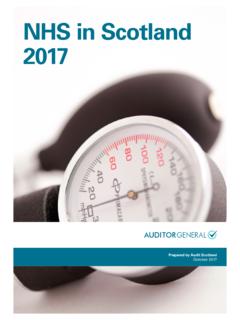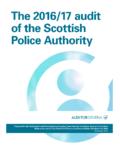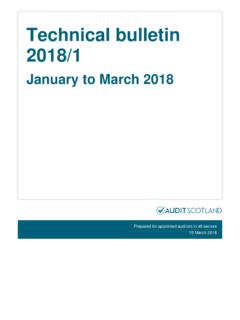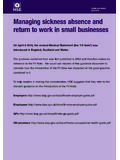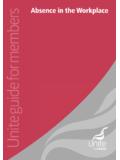Transcription of Hospital cleaning - Home | Audit Scotland
1 PERFORMANCE Audit . Hospital cleaning PREPARED BY Audit Scotland JANUARY 2003. Hospital cleaning A report to the Scottish Parliament by the Auditor General for Scotland Auditor General for Scotland The Auditor General for Scotland is the Parliament's watchdog for ensuring propriety and value for money in the spending of public funds. He is responsible for investigating whether public spending bodies achieve the best possible value for money and adhere to the highest standards of financial management. He is independent and not subject to the control of any member of the Scottish Executive or the Parliament.
2 The Auditor General is responsible for securing the Audit of the Scottish Executive and most other public sector bodies except local authorities and fire and police boards. The following bodies fall within the remit of the Auditor General: departments of the Scottish Executive eg the Health Department executive agencies eg the Prison Service, Historic Scotland NHS boards and trusts further education colleges water authorities NDPBs and others eg Scottish Enterprise. Audit Scotland Audit Scotland is a statutory body set up in April 2000 under the Public Finance and Accountability ( Scotland ) Act 2000.
3 It provides services to the Accounts Commission and the Auditor General for Scotland . Together they ensure that the Scottish Executive and public sector bodies in Scotland are held to account for the proper, efficient and effective use of public funds. Acknowledgements Audit Scotland is grateful to the trust and island board staff who acted as peer reviewers during this study. We are also grateful to Isabella Dickie and Linda McLelland for their assistance. The support of trusts and islands health boards in completing data collection questionnaires is gratefully acknowledged.
4 Tricia Meldrum and John Simmons managed the review under the general direction of Barbara Hurst, Director of Performance Audit . AGS/2003/2. Contents Summary ..3. Introduction ..8. Level of cleanliness ..12. Inputs to cleaning , supervision and monitoring ..18. Compliance with CSBS standards for cleaning services ..27. Management of cleaning services ..34. Conclusions ..47. Summary of recommendations ..50. Appendix 1: Cleanliness review methods ..52. Appendix 2: Levels of cleanliness in hospitals ..54. Appendix 3: Wards included in the questionnaire survey.
5 57. Appendix 4: Planned and actual cleaning frequencies ..58. Appendix 5: Compliance with CSBS standards ..59. Hospital cleaning 1. Summary Introduction Audit Scotland published A clean bill of health', a baseline review of Hospital cleaning services, in April 2000. This made a number of recommendations aimed at improving the quality and effectiveness of Hospital cleaning . This follow-up review assesses progress against a number of these recommendations. It also includes a review of the level of cleanliness observed in hospitals, providing the first national snapshot.
6 The report investigates the reasons for variations in the levels of cleanliness, looking at issues identified in A clean bill of health'. It considers frequency of cleaning tasks, staff inputs to cleaning and monitoring, recruitment and retention of staff, management arrangements and the application of policies and procedures. The review also incorporates a baseline assessment of compliance with standards for cleaning services issued by the Clinical Standards Board for Scotland (CSBS) in January 2002. Level of cleanliness Local auditors, together with domestic services managers acting as peer reviewers, visited 74 hospitals throughout Scotland between March and May 2002.
7 They reviewed the level of cleanliness in a sample of wards and public areas against a number of specified criteria. Each area reviewed was rated as one of four categories: very good, acceptable, need for improvement or concern. This provided a snapshot of the levels of cleanliness in hospitals in Scotland (Appendix 2). We found a very good or acceptable level of cleanliness in over 70%. of wards and 80% of public areas reviewed. Almost half of the hospitals had a very good or acceptable level of cleanliness in all areas reviewed.
8 However, over 20% of hospitals show a clear need for improvement, with the remainder in need of some minor improvement. We recommend that a rolling programme of peer review visits is introduced to assess and improve the level of cleanliness in hospitals. 1. Responsibilities for cleaning clinical equipment are not clearly specified in some hospitals, and the level of cleanliness of some items was found to be unacceptable in 10% of wards reviewed. This 1. Items such as hoists, drip stands and commodes. Hospital cleaning 3. requires co-ordination between domestic services and nursing staff and the development of operational policies with explicit responsibilities.
9 The appearance of wards and public areas varies, and this is not always related to level of cleanliness. Poor maintenance of buildings and fabric, the need for redecoration and dirty windows all contribute to a public perception that standards of cleanliness are poor. In some cases, poor maintenance and decoration can make it more difficult for areas to be cleaned effectively. There is a need for better co-ordination of domestic services and estates management to identify and manage areas of risk. Ward staff interviewed as part of the review were generally aware of areas of concern about levels of cleanliness and felt these were mostly related to insufficient staff hours or cleaning frequencies.
10 In addition to presenting a snapshot indication of the level of cleanliness in hospitals throughout Scotland , this review investigates the reasons for the variation observed. It considers a number of factors that may relate to level of cleanliness: the staff time available for cleaning , supervision and monitoring staff training management arrangements does management provide knowledge and leadership, ensure accountability, manage and minimise risks? the application of comprehensive policies and procedures, developed in collaboration by providers and users.

